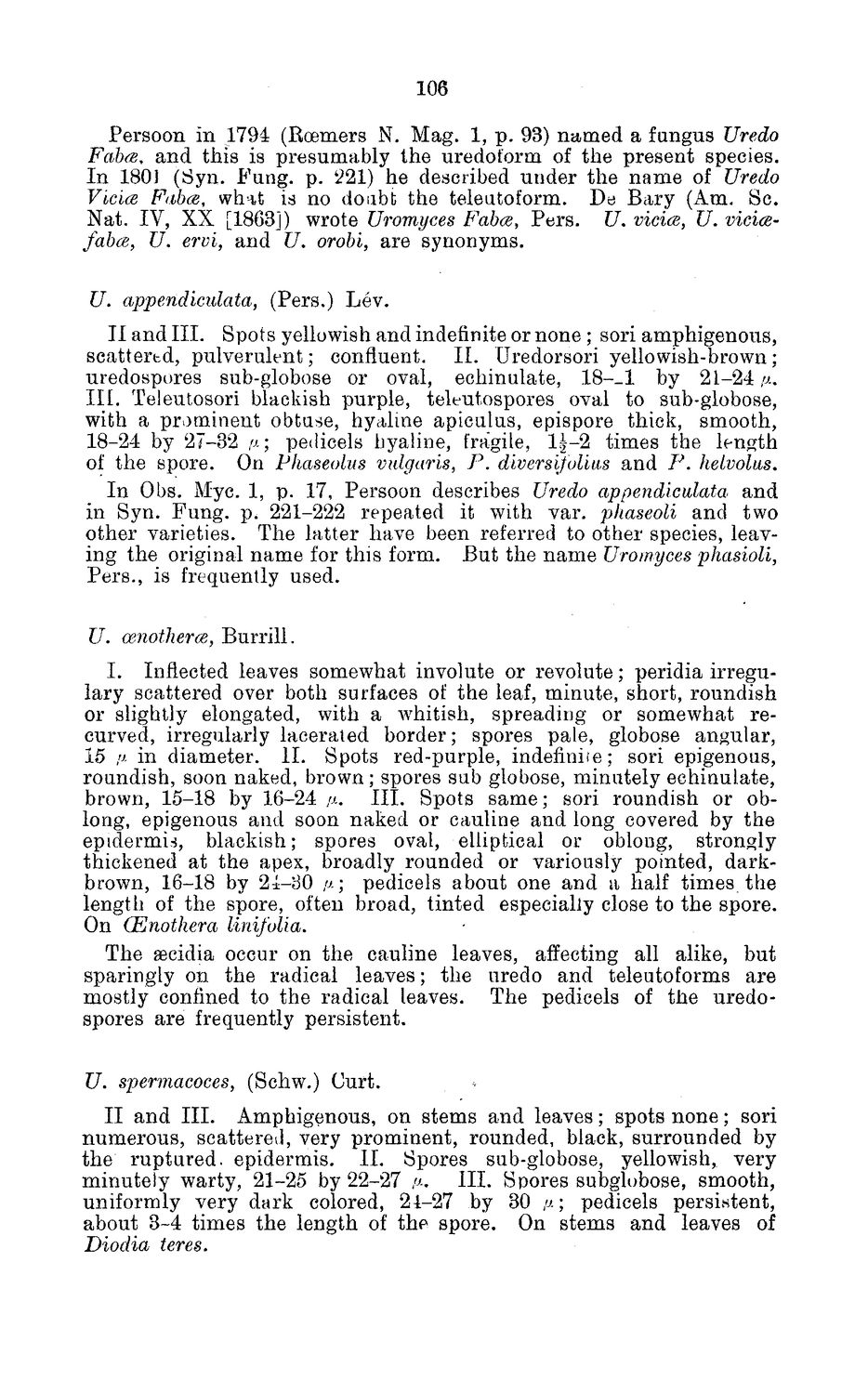| |
| |
Caption: Board of Trustees Minutes - 1884
This is a reduced-resolution page image for fast online browsing.

EXTRACTED TEXT FROM PAGE:
106 Persoon in 1794 (Rcemers N. Mag. 1, p. 93) named a fungus Uredo Faba, and this is presumably the uredoform of the present species. In 1801 (Syn. Fung. p. 221) he described under the name of Uredo Vic ice Fabce, wh-^t is no doubt the teleutoform. De Bary (Am. Sc. Nat. IV, XX [1863]) wrote Uromyces Fabce, Pers. U. vicice, U. vicicefabce, U. ervi, and U. orobi, are synonyms. U. appendiculata, (Pers.) Lev. II and III. Spots yellowish and indefinite or none ; sori amphigenous, scattered, pulverulent; confluent. II. Uredorsori yellowish-brown; uredospores sub-globose or oval, echinulate, 18--1 by 21-24 /*. III. Teleutosori blackish purple, teleutospores oval to sub-globose, with a prominent obtuse, hyaline apiculus, epispore thick, smooth, 18-24 by 27-32 /i; pedicels hyaline, fragile, 1J-2 times the length of the spore. On Pkaseolus vulgaris, P. diversifolius and P. helvolus. In Obs. Myc. 1, p. 17, Persoon describes Uredo appendiculata and in Syn. Fung. p. 221-222 repeated it with var. phaseoli and two other varieties. The latter have been referred to other species, leaving the original name for this form. But the name Uromyces phasioli, Pers., is frequently used. U. Oenothera, Burrill. I. Inflected leaves somewhat involute or revolute; peridia irregulary scattered over both surfaces of the leaf, minute, short, roundish or slightly elongated, with a whitish, spreading or somewhat recurved, irregularly lacerated border; spores pale, globose angular, 15 tu in diameter. II. Spots red-purple, indefinite; sori epigenous, roundish, soon naked, brown; spores sub globose, minutely echinulate, brown, 15-18 by 16-24 p.. III. Spots same; sori roundish or oblong, epigenous and soon naked or cauline and long covered by the epidermis, blackish; spores oval, elliptical or oblong, strongly thickened at the apex, broadly rounded or variously pointed, darkbrown, 16-18 by 24-80 //; pedicels about one and a half times the length of the spore, often broad, tinted especially close to the spore. On (Enothera linifolia. The aecidia occur on the cauline leaves, affecting all alike, but sparingly on the radical leaves; the uredo and teleutoforms are mostly confined to the radical leaves. The pedicels of the uredospores are frequently persistent. U. spermacoces, (Schw.) Curt. II and III. Amphigenous, on stems and leaves; spots none; sori numerous, scattered, very prominent, rounded, black, surrounded by the ruptured, epidermis. II. Spores sub-globose, yellowish^ very minutely warty, 21-25 by 22-27 /->-. III. Spores subglobose, smooth, uniformly very dark colored, 24-27 by 30 /*; pedicels persistent, about 3-4 times the length of the spore. On stems and leaves of Diodia teres.
| |